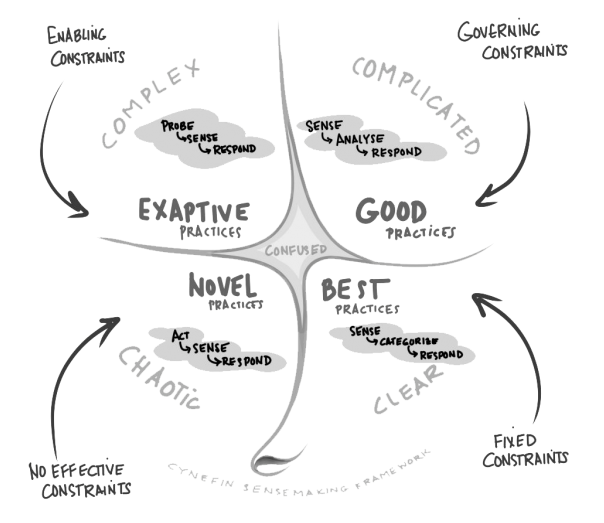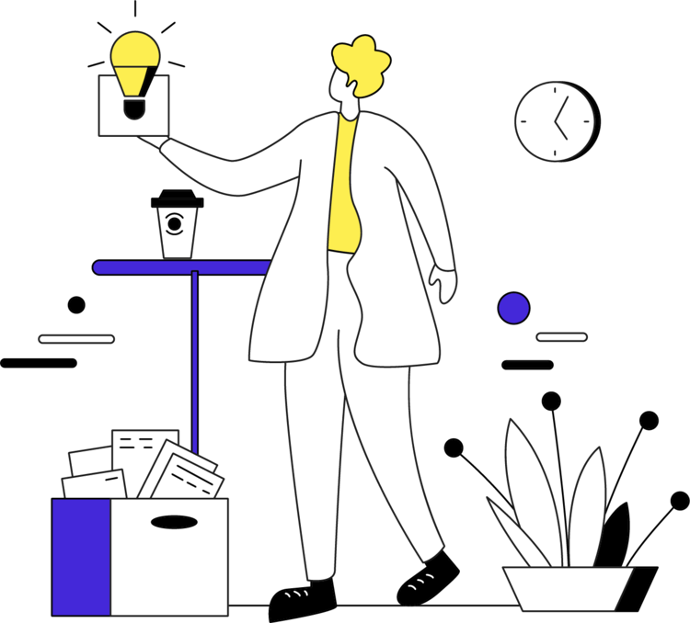SYSTEM THINKING: COMPLEX ADAPTATIVE SYSTEMS & CYNEFIN
What is a Complex Adaptative System?
A Complex Adaptive System is a system made up of many individual parts or agents, a large-scale system whose behaviors
may change, evolve, or adapt.
A Complex Adaptive System has three characteristics. The first is that the system consists of a number of heterogeneous agents, and each of those agents makes decisions about how to behave. The most important dimension here is that those decisions will evolve over time. The second characteristic is that the agents interact with one another. That interaction leads to the third—something that scientists call emergence: In a very real way, the whole becomes greater than the sum of the parts. The key issue is that you can’t really understand the whole system by simply looking at its individual parts.
Complex adaptive systems are one of nature’s big solutions, so biology is full of great examples. Ant colonies are solving very complicated, very challenging problems with no leadership, no strategic plan, no Congress.
Once you’re aware of how the structure works, though, you’ll see these systems everywhere—the city of Boston, the neurons in your brain, the cells in your immune system, the stock market. The basic features—heterogeneous agents, interaction, and an emergent global system—are consistent across domains.
What is the Cynefin framework?

The Cynefin® Framework was developed to help leaders understand their challenges and to make decisions in context. By distinguishing different domains (the subsystems in which we operate), it recognises that our actions need to match the reality we find ourselves in through a process of sense-making. This helps leaders cultivate an awareness of what is really complex and what is not and respond accordingly, so that no energy is wasted in overthinking the routine but they also never try to make the complex fit into standard solutions.
The Cynefin Framework is and has been used in almost every conceivable sector: whether strategy, police work, international development, public policy, military, counterterrorism, safety, energy, healthcare, sales or education it has had something to offer. In this video, Dave Snowden introduces the Cynefin framework with a brief explanation of its origin and evolution and a detailed discussion of its architecture and function.
Learning Objectives:
This course introduces the concepts and theories that are foundational to the Cynefin framework and is intended for those who are new to Cynefin and would like to cover the basics.
1. Introduction to the Cynefin framework
1.1 Understand the different contexts that exist;
1.2 Learn how to identify the Simple domain and the exploration of best practices;
1.3 Learn the key aspects of the Complicated domain and how to take the best of this scenario;
1.4 Understand the differences between Complicated, Complex and Chaotic scenarios and how to learn from them;
1.5 Learn the concept of Evolution brought by the Cynefin framework.
2. Complex Adaptative Systems
2.1 Learn the concept of Evolution brought by the Cynefin framework;
2.2 Understand what skills are needed to better provide a more effective approach to changing systems;
2.3 Understand what tools can bring a better respond to each context, and how to pivot existing ones.
And much more ...

WITH YOUR ACADEMY YOU'LL BECOME A MEMBER OF OUR COMMUNITY:
Share experiences, tips, and other insightful knowledge with a community of Agile practitioners.
-
Insightful case studies
-
Access to XA Week content
-
Access to an Agile employment marketplace
-
Self-study materials
-
Open door to a network of Agile practitioners
-
Invitation to exclusive master classes & webinars
Our programs leverage a range of highly dynamic teaching methodologies, including cohort assignments, class lectures, exercises and case studies, all aimed at improving your skills as an agent of change.
These teaching methods have been strategically combined to foster an optimal learning environment.
Ready to change the way you work?